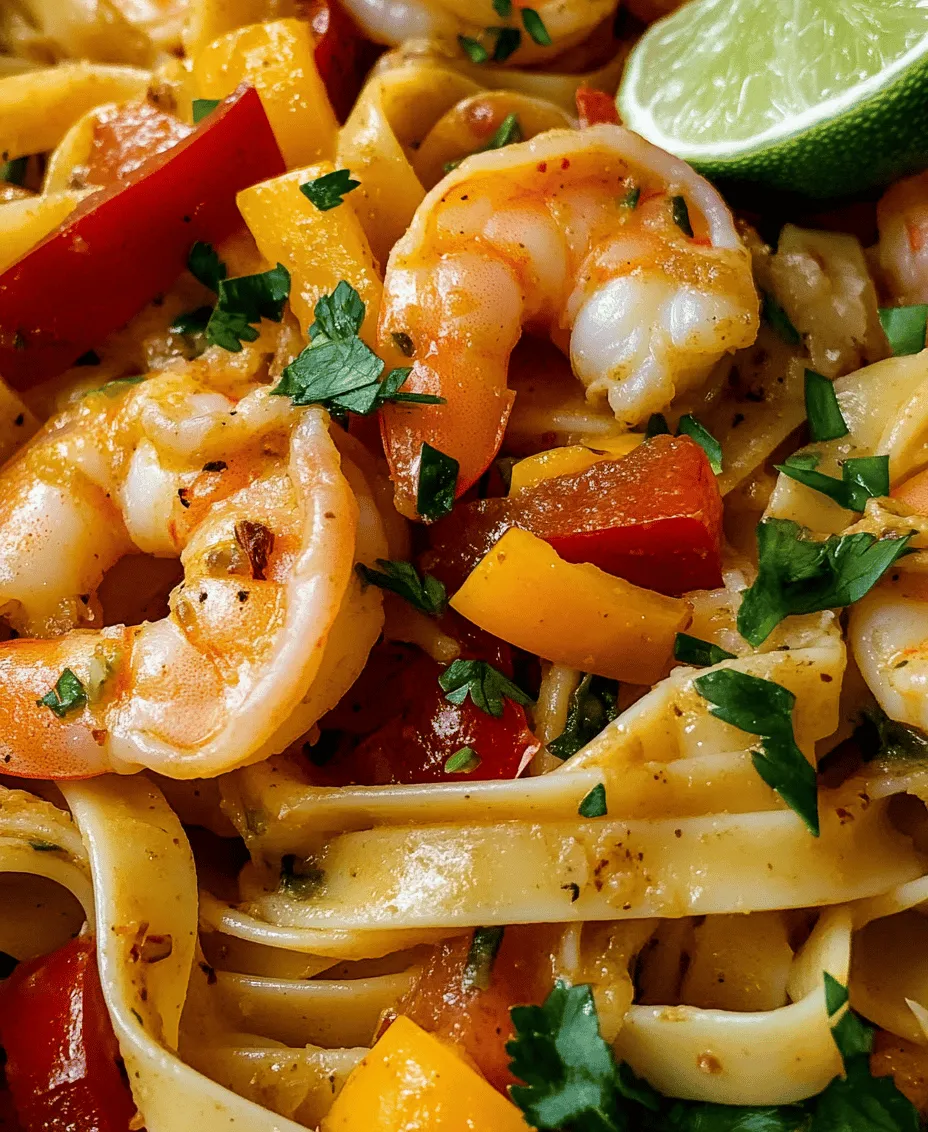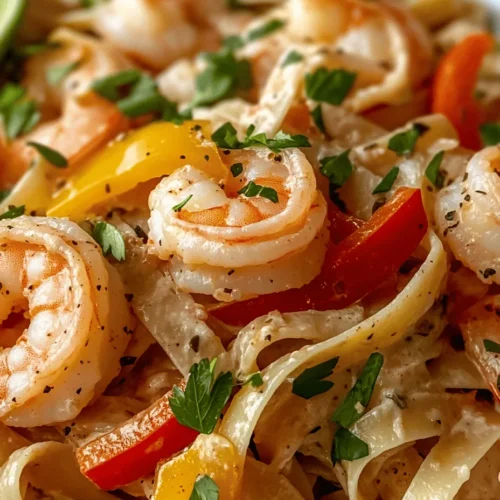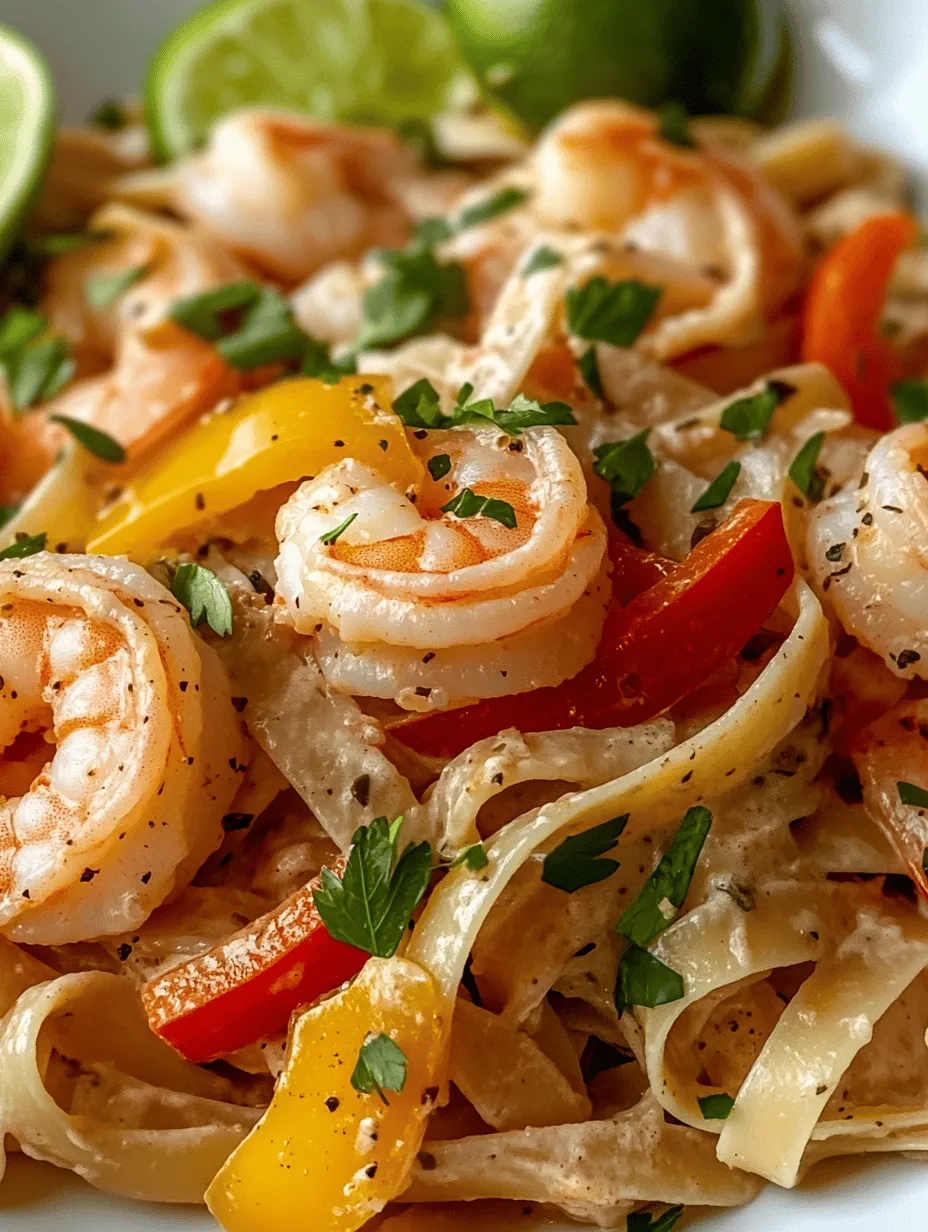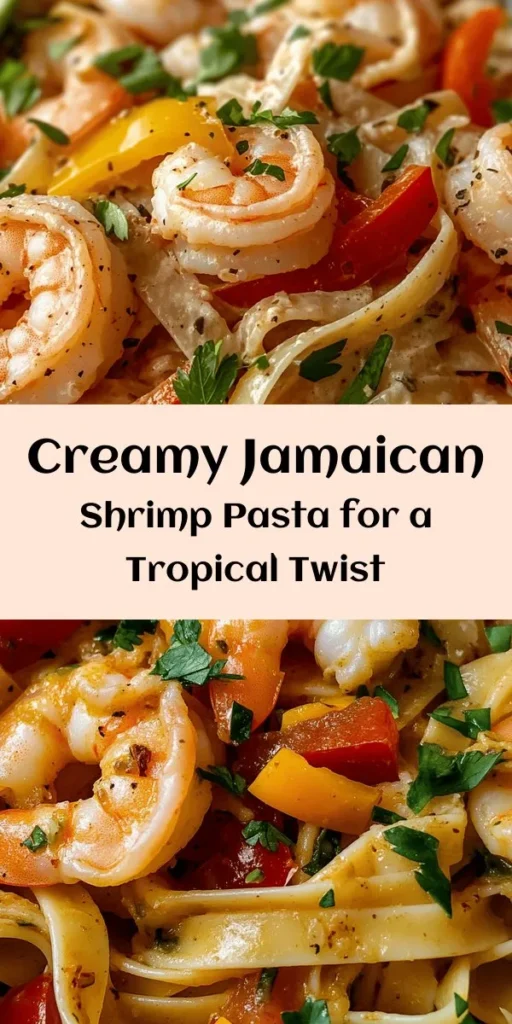Introduction
Embark on a culinary journey to Jamaica with this delightful Jamaican Shrimp Pasta recipe, a perfect blend of creamy coconut, vibrant peppers, and succulent shrimp. This dish not only offers a rich and satisfying flavor profile but also showcases the essence of Caribbean cuisine. Imagine the warmth of the sun-drenched beaches, the rhythmic sounds of reggae music, and the aromatic spices wafting through the air. In this blog post, we will explore the ingredients, preparation steps, and the cultural significance of this dish, allowing you to appreciate each bite as you indulge in a delightful experience.
Jamaican cuisine is a vibrant tapestry of flavors, colors, and textures, deeply rooted in the island’s history and cultural heritage. The islands’ diverse influences—from the indigenous Taino people to the African, European, and Asian settlers—have all left their mark on the culinary landscape. This is especially true in dishes like Jamaican Shrimp Pasta, which beautifully marries the comfort of Italian pasta with the bold, exotic flavors characteristic of Jamaican fare.
Understanding Jamaican Cuisine
The Roots of Jamaican Culinary Traditions
Jamaican cuisine is a melting pot of influences, creating a distinct culinary identity that is celebrated worldwide. The island’s rich history is reflected in its food, with local ingredients and techniques shaped by the various cultures that have come together over centuries. The indigenous Taino people introduced cassava, sweet potatoes, and tropical fruits, while African slaves contributed their cooking methods and spices, including the famous jerk seasoning, which blends allspice, thyme, and Scotch bonnet peppers.
The use of fresh, local ingredients is a hallmark of Jamaican cooking. From seafood caught in the surrounding Caribbean Sea to vibrant produce grown in the island’s fertile soil, each dish showcases the bounty of the land and sea. The emphasis on bold flavors, often achieved through marinating and slow cooking, allows for an explosion of taste in every bite.
Exploration of Key Ingredients Commonly Used in Jamaican Cooking
Key ingredients in Jamaican cooking include spices such as allspice (known locally as pimento), Scotch bonnet peppers for heat, garlic, onions, and various herbs. These ingredients form the backbone of many traditional dishes, providing depth and complexity that is both comforting and invigorating.
Coconut milk is another staple, often used to create a creamy texture in soups, stews, and curries. In the case of Jamaican Shrimp Pasta, coconut milk serves as the luscious base that ties together the flavors of the shrimp and vegetables, making for a truly indulgent experience.
How Flavors Reflect the Island’s Culture and Heritage
The flavors of Jamaican cuisine reflect the island’s vibrant culture and heritage. The use of spices and fresh ingredients not only showcases the island’s agricultural richness but also tells stories of resilience and celebration. Meals are often communal, bringing families and friends together to share not just food but also love, laughter, and joy.
Dishes like jerk chicken, ackee and saltfish, and now Jamaican Shrimp Pasta illustrate the island’s ability to adapt and incorporate diverse elements while remaining true to its roots. This pasta dish exemplifies the culinary fusion that is characteristic of modern Jamaican cooking, allowing individuals to enjoy a taste of the Caribbean in a format that is familiar and comforting.
Overview of Jamaican Shrimp Pasta
What Makes This Dish Unique
Jamaican Shrimp Pasta stands out because it combines the best of both worlds—the creamy, comforting nature of Italian pasta with the bold, exciting flavors of Jamaican cuisine. This unique fusion not only makes for an appealing dish but also allows home cooks to explore new flavor combinations that are both satisfying and refreshing.
The use of coconut milk adds a rich, creamy element that beautifully complements the sweetness of the shrimp and the crunch of fresh vegetables. Additionally, the incorporation of jerk seasoning infuses the dish with a signature spice that elevates it beyond traditional pasta recipes. The result is a tantalizing experience that transports you straight to the shores of Jamaica with every bite.
The Fusion of Italian Pasta with Caribbean Flavors
The fusion of Italian pasta with Caribbean flavors is a brilliant culinary innovation that celebrates the versatility of both cuisines. Whether you choose fettuccine or linguine, the pasta acts as a perfect canvas, soaking up the delicious coconut sauce and absorbing the spices from the shrimp and vegetables. This dish is not only a celebration of flavor but also an invitation to experiment with different ingredients and cooking techniques.
The vibrant colors of the dish, with red and yellow bell peppers, bright green herbs, and succulent pink shrimp, make it visually appealing as well. This attention to aesthetics is a hallmark of Jamaican cooking, where the presentation is just as important as the taste. By combining these elements, Jamaican Shrimp Pasta becomes more than just a meal; it transforms into a feast for the senses.
Ingredients Breakdown
Key Components of Jamaican Shrimp Pasta
To create the perfect Jamaican Shrimp Pasta, you’ll need a selection of key ingredients that work harmoniously to deliver exceptional flavor and texture. Here’s a detailed description of each ingredient and its role in this dish:
1. Shrimp: The star of the dish, shrimp provide a delicate sweetness and tender texture. They are not only delicious but also a great source of protein and omega-3 fatty acids, making them a healthy choice for your pasta dish.
2. Pasta: Fettuccine or linguine serves as the base of the dish. These pasta types have a flat surface area that allows the creamy sauce to cling beautifully, ensuring every bite is flavorful.
3. Coconut Milk: This creamy, rich ingredient adds a tropical flair and a velvety texture to the sauce. Coconut milk is lower in fat than heavy cream but still provides the creaminess required for a satisfying pasta dish.
4. Jerk Seasoning: The hallmark of Jamaican cuisine, jerk seasoning infuses the shrimp with a spicy warmth and complexity. It often contains a blend of spices such as allspice, thyme, and Scotch bonnet peppers, which add depth and character to the dish.
5. Bell Peppers: Red and yellow bell peppers lend a sweet crunch and vibrant color to the pasta, enhancing both the flavor and presentation. They also provide a good dose of vitamins and antioxidants.
6. Garlic and Onion: These aromatics are essential for building a flavorful foundation in the dish. Sautéing them releases their natural sweetness and enhances the overall flavor profile.
7. Fresh Herbs: Chopped cilantro or parsley adds a refreshing burst of flavor and a pop of color, making the dish visually appealing and aromatic.
Health Benefits of Shrimp and Fresh Vegetables
In addition to their delicious taste, shrimp and fresh vegetables offer numerous health benefits. Shrimp is low in calories and high in protein, making it a fantastic option for those looking to maintain a healthy diet. They are also a great source of essential nutrients such as selenium, vitamin B12, and iodine.
Fresh vegetables like bell peppers not only add flavor but also contribute vital vitamins and minerals to your meal. They are rich in antioxidants, which can help reduce the risk of chronic diseases and promote overall health. By incorporating these ingredients into your Jamaican Shrimp Pasta, you can enjoy a dish that is not only satisfying but also nutritious.
The Importance of Using Quality Ingredients
When it comes to preparing Jamaican Shrimp Pasta, the quality of your ingredients plays a pivotal role in the final outcome. Fresh, sustainably sourced shrimp will elevate the dish, providing a better flavor and texture. Opt for high-quality coconut milk, preferably organic and free from additives, to achieve that luscious creaminess.
Similarly, choosing vibrant, fresh vegetables will ensure that your dish is both visually stunning and packed with flavor. When you prioritize quality ingredients, you not only enhance the taste of your dish but also create a more enjoyable cooking experience.
Cooking Equipment Needed
Essential Tools for Preparation
To make Jamaican Shrimp Pasta, you’ll need a few essential kitchen tools that will streamline the cooking process and help you achieve the best results:
1. Large Pot: A large pot is necessary for boiling the pasta. Make sure it’s big enough to allow the pasta to cook evenly without sticking together.
2. Colander: This handy tool will help you drain the pasta once it’s cooked, allowing you to toss it with the sauce without any excess water.
3. Skillet or Frying Pan: A large skillet is ideal for sautéing the shrimp and vegetables. A non-stick surface will help prevent sticking and make for easier cleanup.
4. Wooden Spoon or Spatula: Use a wooden spoon or spatula to stir the ingredients, ensuring even cooking and flavor distribution.
5. Measuring Cups and Spoons: Accurate measurements are vital for achieving the right balance of flavors, so have your measuring cups and spoons at the ready.
Tips on Choosing the Right Kitchen Tools for Optimal Results
When selecting your kitchen tools, consider their quality and durability. Investing in good-quality pots and pans can make a significant difference in your cooking experience. Non-stick surfaces, for instance, can make cooking and cleanup much easier, while stainless steel options can provide better heat distribution.
Additionally, ensure that your utensils are comfortable to hold and easy to maneuver. This will help prevent fatigue while cooking, allowing you to focus on creating a delicious meal. With the right tools in hand, you’ll be well-equipped to prepare a mouthwatering Jamaican Shrimp Pasta that is sure to impress.
Step-by-Step Cooking Instructions
Preparing the Pasta
Cooking the pasta to perfection is the first step in creating your Jamaican Shrimp Pasta. Follow these simple steps to achieve that ideal al dente texture:
1. Boil Water: Fill a large pot with water and bring it to a rapid boil. Salt the water generously; this is your chance to season the pasta itself.
2. Add Pasta: Once the water is boiling, add your fettuccine or linguine. Stir gently to prevent sticking, and set a timer according to the package instructions—usually around 8-10 minutes.
3. Check for Doneness: Taste a piece of pasta a minute or two before the timer goes off. It should be firm to the bite but not hard. This is what is known as “al dente,” which means “to the tooth” in Italian.
4. Drain the Pasta: Once the pasta is cooked to your liking, carefully drain it in a colander. Do not rinse the pasta, as this can wash away the starches that help the sauce adhere.
Tips for Achieving the Ideal Al Dente Texture
To achieve the perfect al dente texture, it’s important to keep an eye on the cooking time and to taste the pasta frequently. If you overcook it, the pasta will become mushy and lose its appealing bite.
Additionally, remember that the pasta will continue to cook slightly even after it’s been drained, so removing it from the heat just before it reaches the desired doneness is a great strategy. This way, you can enjoy a perfectly cooked pasta as you combine it with the creamy shrimp and vegetable sauce.
Sautéing the Vegetables
Sautéing the vegetables is a crucial step to enhance the flavors in your Jamaican Shrimp Pasta. Here’s how to do it:
1. Heat the Skillet: Place your skillet over medium heat and add a splash of olive oil. Allow it to heat up until it shimmers.
2. Add Aromatics: Start by adding minced garlic and diced onion to the skillet. Sauté them for about 2-3 minutes until they become fragrant and translucent.
3. Incorporate Vegetables: Add the chopped bell peppers to the skillet and continue to sauté for another 3-5 minutes, or until they soften and begin to caramelize. The goal is to develop a rich flavor base that will combine beautifully with the shrimp.
4. Season the Mixture: While the vegetables are cooking, sprinkle in some salt and pepper to taste. This will help build layers of flavor in the dish.
The importance of sautéing lies in the Maillard reaction, which occurs when food is cooked at high temperatures, creating complex flavors and a delightful aroma. This initial step sets the stage for a delicious Jamaican Shrimp Pasta that will leave your taste buds dancing with joy.
By blending the creamy coconut milk with the sautéed shrimp and vegetables, you will soon have a dish that not only satisfies your hunger but also transports you to the vibrant landscapes of Jamaica. As you continue through the recipe, remember to savor each moment, from the aromas wafting through your kitchen to the first delightful bite of your finished dish. Stay tuned for the next part, where we will dive deeper into the cooking process and finalize this delicious creation!

How to Achieve the Right Texture for Onions and Bell Peppers
To create the perfect Jamaican Shrimp Pasta, you need to start with properly sautéed onions and bell peppers, as their texture can significantly influence the dish’s overall appeal. Begin by dicing one medium onion and slicing one red bell pepper and one green bell pepper into thin strips.
Heat a tablespoon of olive oil in a large skillet over medium heat. Once the oil is hot, add the onions first, allowing them to cook for about 2-3 minutes until they become translucent. This process is crucial because it releases their natural sweetness, which will complement the dish’s flavors. Next, add the bell peppers and sauté them for an additional 3-5 minutes. You want them to soften but still retain a slight crunch. The vibrant colors and fresh aroma of the sautéed vegetables will set the stage for the shrimp and creamy sauce that follows.
Cooking the Shrimp
Cooking shrimp perfectly is vital for a successful Jamaican Shrimp Pasta. Start by selecting fresh or frozen shrimp, preferably large or extra-large, as they hold up better in the dish. If using frozen shrimp, ensure they are fully thawed before cooking.
In the same skillet used for the onions and bell peppers, add another tablespoon of olive oil and increase the heat to medium-high. Once the oil is shimmering, add the shrimp in a single layer. Avoid overcrowding the pan, as this will cause the shrimp to steam rather than sear. Cook the shrimp for about 2-3 minutes on one side until they turn a lovely pink color and develop a slight char. Flip them over and cook for an additional 1-2 minutes on the other side.
Techniques for Ensuring Shrimp Are Cooked Perfectly
To achieve perfectly cooked shrimp, keep a close eye on their color and texture. The shrimp should transition from a grayish color to a vibrant pink with opaque flesh. Overcooking shrimp can lead to a rubbery texture, so it’s essential to remove them from the heat as soon as they are done.
Signs to Look for to Know When Shrimp Are Done
The best indicators that shrimp are cooked are their color and shape. When shrimp curl into a tight “C” shape, they are often overcooked. Instead, look for a gentle curve and a bright pink hue. Additionally, if you notice the flesh is opaque, that’s a strong indication that the shrimp are ready for the next step.
Creating the Creamy Sauce
With the shrimp perfectly cooked, it’s time to create the creamy sauce that will envelop the pasta and seafood in rich flavors. Begin by lowering the heat to medium and adding a can of coconut milk to the skillet. The coconut milk adds a luscious creaminess and a subtle sweetness that pairs beautifully with the spices.
Detailed Instructions on Combining Spices with Coconut Milk
To enhance the sauce, add the following spices: 1 teaspoon of garlic powder, 1 teaspoon of onion powder, and 1 teaspoon of paprika. For a touch of heat, consider adding a pinch of cayenne pepper or some chopped fresh Scotch bonnet pepper, which is a staple in Jamaican cuisine. Stir the mixture well to ensure the spices are evenly distributed throughout the coconut milk.
The Role of Simmering in Flavor Development
Allow the sauce to simmer gently for about 5-7 minutes. This step is crucial as it allows the flavors to meld and develop. Stir occasionally to prevent sticking, and you’ll notice the sauce thickening slightly. The aroma will be enticing, filling your kitchen with the essence of Jamaica.
Adjusting Seasoning to Taste
As the sauce simmers, taste it for seasoning. This is your opportunity to adjust the flavors according to your preference. Add salt and pepper gradually, and consider incorporating a splash of lime juice for brightness. The acidity from the lime will balance the richness of the coconut milk.
Combining Ingredients
Once your sauce is ready, it’s time to bring everything together. First, cook your pasta of choice according to package instructions until al dente. Linguine or fettuccine works well for this dish. Reserve about half a cup of pasta water before draining, as the starchy water can help adjust the sauce’s consistency if needed.
How to Effectively Mix Pasta with the Sauce and Shrimp
In the skillet with the creamy sauce, add the drained pasta followed by the cooked shrimp. Toss everything together gently using tongs or a large spoon. If the sauce appears too thick, add a splash of the reserved pasta water to loosen it and help the sauce cling to the pasta.
Tips for Ensuring Even Distribution of Flavors
To ensure even distribution of flavors, make sure to coat all pasta strands with the sauce. Stirring gently but thoroughly will help incorporate the shrimp and vegetables, ensuring that every bite offers a delightful combination of flavors.
Serving Suggestions
Presentation Tips for Jamaican Shrimp Pasta
When it comes to serving your Jamaican Shrimp Pasta, presentation is key. Use a large serving bowl or individual plates to showcase the vibrant colors of the dish. Twirl the pasta into nests for a more elegant presentation, allowing the shrimp and bell peppers to peek through.
Ideas for Garnishing to Enhance Visual Appeal
For an extra touch, garnish with freshly chopped parsley or cilantro, which adds a pop of color along with fresh flavor. A sprinkle of red pepper flakes can also enhance the visual appeal while adding a hint of heat. For those who love cheese, consider grating a bit of Parmesan over the top, though this is not traditional in Jamaican cuisine.
Pairing Recommendations for Sides and Beverages
Pair your Jamaican Shrimp Pasta with a light salad drizzled with a citrus vinaigrette to balance the richness of the dish. For beverages, consider serving it with a chilled glass of white wine, such as Sauvignon Blanc or a refreshing ginger beer, which complements the Caribbean flavors beautifully.
Nutritional Information
Health Aspects of Jamaican Shrimp Pasta
Jamaican Shrimp Pasta is not only delicious but can also be a nutritious choice. Shrimp is an excellent source of lean protein, providing essential amino acids while being low in calories and fat. The dish is enriched with the health benefits of bell peppers, which are high in vitamins A and C, and coconut milk, which contains medium-chain triglycerides that can support metabolic health.
Caloric Breakdown and Nutritional Values
While exact caloric values can vary based on ingredient choices, a standard serving of Jamaican Shrimp Pasta typically contains around 400-500 calories. This includes a good balance of protein, healthy fats, and carbohydrates. If you want to reduce calories, consider using whole grain pasta or zucchini noodles as a substitute.
Possible Dietary Modifications for Different Preferences
For those with dietary restrictions, Jamaican Shrimp Pasta can be easily modified. For a gluten-free version, use gluten-free pasta, and if you prefer a dairy-free option, coconut milk is already a great choice. Vegetarians can substitute shrimp with sautéed mushrooms or tofu, capturing the dish’s essence without compromising on flavor.
Cultural Significance
The Importance of Shrimp in Jamaican Culture
Seafood holds a special place in Jamaican cuisine, reflecting the island’s rich maritime heritage. Shrimp, in particular, is a popular ingredient in many traditional dishes, showcasing the abundance of fresh seafood available along the coast. From stews to curries, shrimp is celebrated for its versatility and ability to absorb bold flavors.
The Role of Pasta Dishes in Modern Jamaican Cuisine
While pasta may not be a traditional Jamaican staple, its inclusion in Jamaican cuisine represents the influences of global culinary trends. Jamaican Shrimp Pasta is a fusion dish that marries local ingredients with international flavors, making it a prime example of how Jamaican cooking continues to evolve while celebrating its roots.
Conclusion
In summary, Jamaican Shrimp Pasta is not just a meal; it’s an experience that transports you to the vibrant shores of Jamaica. This dish brings together the richness of Caribbean flavors with the comfort of pasta, making it an ideal choice for both weeknight dinners and special occasions. Enjoy the creamy delight of this recipe, and let the unique blend of ingredients inspire your culinary adventures. Indulge in the harmony of shrimp, spices, and creamy sauce, and let each bite remind you of the beauty of Jamaican culture and cuisine.



